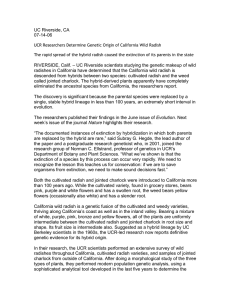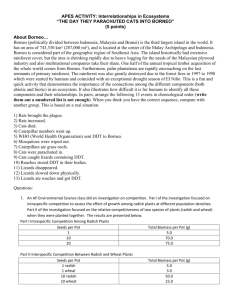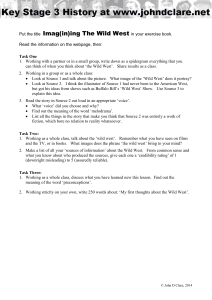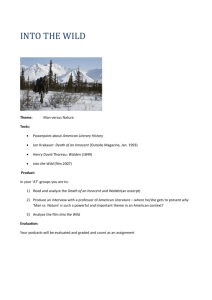Managing Wild Radish in Wheat Wild Radish Biology
advertisement
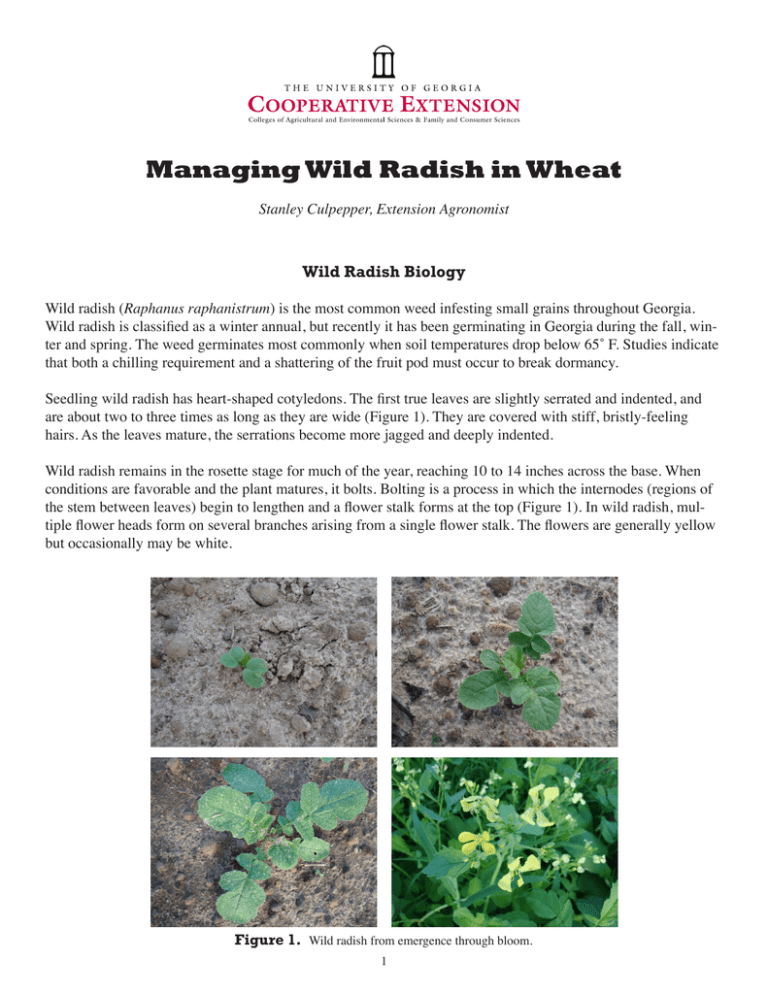
Managing Wild Radish in Wheat Stanley Culpepper, Extension Agronomist Wild Radish Biology Wild radish (Raphanus raphanistrum) is the most common weed infesting small grains throughout Georgia. Wild radish is classified as a winter annual, but recently it has been germinating in Georgia during the fall, winter and spring. The weed germinates most commonly when soil temperatures drop below 65˚ F. Studies indicate that both a chilling requirement and a shattering of the fruit pod must occur to break dormancy. Seedling wild radish has heart-shaped cotyledons. The first true leaves are slightly serrated and indented, and are about two to three times as long as they are wide (Figure 1). They are covered with stiff, bristly-feeling hairs. As the leaves mature, the serrations become more jagged and deeply indented. Wild radish remains in the rosette stage for much of the year, reaching 10 to 14 inches across the base. When conditions are favorable and the plant matures, it bolts. Bolting is a process in which the internodes (regions of the stem between leaves) begin to lengthen and a flower stalk forms at the top (Figure 1). In wild radish, multiple flower heads form on several branches arising from a single flower stalk. The flowers are generally yellow but occasionally may be white. Figure 1. Wild radish from emergence through bloom. 1 Economic Importance Wild radish competes with crops for water, light, nutrients and physical space. In addition, the seed stalk can interfere with harvesting by causing an inefficient combine operation. Wild radish seed pods often contaminate harvested grain, thereby reducing profits due to excess cleaning costs. Instead of shattering and releasing seeds, the seed pod dries down and fragments into small sections, each containing a single seed (Figure 2). These seed pods are very close in size and shape to wheat and other small grains and are extremely difficult to remove in a routine cleaning process. Figure 2. Wild radish seed pods (left) and wheat seeds (right). In addition to having a direct impact on small grain yield and/or quality, wild radish can harbor many serious insects and diseases, including blackleg (Leptosphaeria maculans), a major disease problem for canola and cabbage. Heavy wild radish infestations could provide enough inoculum to cause problems in some rotational Wild Radish Control Cultural Control Methods: Weeds are often controlled most effectively through cultural practices that result in rapid small grain stand establishment and canopy development, which provides an undesirable environment for weed growth. Cultural practices include: 1) 2) 3) 4) 5) Planting certified seed (free of weed seeds) Good, weed-free seedbed preparation Proper fertilization Seeding at the proper rate and time Disease and insect management Mechanical Control Methods: Wheat and other grains are either planted in narrow rows (drilled) or broadcast seeded and disked in, making mechanical cultivation impossible. Mowing would help reduce seed production, but wild radish does not begin to bolt until the grain begins to joint. Because of these factors, mechanical control is not considered an option for small grain weed control; however, mowing could be a fair alternative in small grains used for grazing. Chemical Control Methods: If applying herbicides, read and follow label recommendations. Generally, larger weeds are more difficult to control than smaller weeds; therefore, timely herbicide applications are critical. Many of the herbicides used in wheat affect growth processes within the target weed. In essence, the more actively the plant grows, the better the control. Applications made to stressed weeds (e.g., drought, wet, cold, heat) will often result in decreased control. Many herbicides should be applied only during certain stages of wheat development to avoid crop injury (Figure 3, Table 2). Although the stage of development provides a good indicator for application timing, factors such as environmental conditions, crop health and variety (early vs. late maturity) also impact crop tolerance. 2,4-D or MCPA. These phenoxy herbicides are extremely effective in controlling wild radish (Table 1). Applications of 2,4-D (3.8 lb active/gal) or MCPA (4.0 lb active/gal) at 1.0 to 1.25 pt/A are recommended for wild radish 8 inches or less in diameter. These herbicides often do not adequately control chickweed and henbit. Mixtures of 2,4-D or MCPA with Harmony or Express are advised for most fields. 2 Application timing for these herbicides is critical. The critical period for 2,4-D applications is after wheat is fully tillered but before jointing (Feekes stages 4 and 5, Figure 3). Application before this growth stage may cause a “rat-tail” effect whereby the leaf does not form and unfurl properly. The crop may appear stunted and be delayed in maturity, and tiller development may be adversely affected. Conversely, application after jointing has commenced may result in malformed seed heads. Apply MCPA after wheat tillers (preferably 2+ tillers) but before jointing (Figure 3). Injury (similar to 2,4-D injury) can be observed if MCPA is applied before or after the critical period of application for wheat. In general, MCPA causes less injury to wheat than 2,4-D, but it is also less effective on larger weed species. Harmony Extra. Harmony Extra is a prepackaged mixture of the sulfonylurea herbicides thifensulfuron-methyl and tribenuron-methyl. Harmony Extra controls many winter annual broadleaf weeds, but wild radish must be small (less than 3 inches in diameter) for adequate control (Table 1). 2,4-D or MCPA at 0.25 to 0.375 lb active ingredient/A may be mixed with Harmony Extra for improved wild radish control. A nonionic surfactant at the rate of 1 qt/100 gallons of spray solution is recommended when Harmony Extra is applied in water. An advantage of Harmony Extra compared to 2,4-D is its wide window of application. Harmony Extra can be applied in wheat after the two-leaf stage but before the flag leaf is visible (Figure 3). PowerFlex (active ingredient pyroxsulam) can be applied in wheat at 3.5 oz/A from the three-leaf stage until jointing. In addition to ryegrass, the PowerFlex label claims control of several broadleaf weeds including Carolina geranium, common chickweed, hairy vetch and wild mustard, and suppression of henbit. The label does not mention wild radish but numerous Georgia studies suggest good to excellent control of radish up to 6 inches in diameter. Add crop oil concentrate at 1% v/v (1 gal crop oil/100 gal spray solution) with the application. Osprey (active ingredient mesosulfuron) is a postemergent herbicide applied at a rate of 4.75 oz/A in winter wheat from emergence up to the jointing stage of growth. The manufacturer recommends adding a nonionic surfactant at 0.5% by volume (2 qt/100 gal spray) plus 1 to 2 qt/A of urea ammonium nitrogen fertilizer (28-0-0, 30-0-0, or 32-0-0) or ammonium sulfate fertilizer at 1.5 to 3 lb/A (21-0-0-24). Osprey plus this adjuvant system will normally control wild radish 4 inches in diameter or smaller. Osprey will also provide good control of henbit and common chickweed if applied when these weeds are smaller than 2 inches at time of application. Osprey may be mixed with Harmony Extra to improve control of broadleaf weeds, including wild radish. 3 Table 1. The Effect of Stage of Growth on Wild Radish Control in Wheat. Stage of Growth1 Herbicide 0-4 inches 4-8 inches 8-12 inches Bolting/Flowering 2,4-D 2 >95% >95% >85% 60-75% MCPA >95% >90% >70% 50-60% Peak >90% >85% 75-85% <40% Express 85-90% >60% 50% <40% Harmony Extra 85-90% 70-80% 50% <40% Express + MCPA >95% >95% >85% 60-75% Osprey >95% 70-80% 60-70% 50-60% PowerFlex >95% >85% >80% 60-75% Wild radish size in diameter of leaf rosette. Percent control as compared to untreated areas. 1 2 Table 2. The Effect of Stage of Growth on Wheat Injury by Various Herbicides. Stage of Growth1 Herbicide 0-1 tiller 2-3 tillers full tiller Jointing 2,4-D 2 >80% 35% 0-10% 70-90% MCPA >30% 10% 0-5% 50-70% Peak 0-5% 0-5% 0-5% 5-10% Express 0-5% 0-5% 0-5% 5-10% Harmony Extra 0-5% 0-5% 0-5% 5-10% Express + MCPA >30% 5% 0-5% 50-80% Osprey 0-5% 0-5% 0-5% 0-5% PowerFlex 0-5% 0-5% 0-5% 0-5% Refer to Figure 3 and the Small Grain Production Guide for growth stages. Percent injury (visual chlorosis or necrosis or tiller malformation). 1 2 Circular 839 Revised October 2009 The University of Georgia and Ft. Valley State University, the U.S. Department of Agriculture and counties of the state cooperating. Cooperative Extension, the University of Georgia College of Agricultural and Environmental Sciences, offers educational programs, assistance and materials to all people without regard to race, color, national origin, age, gender or disability. An Equal Opportunity Employer/Affirmative Action Organization Committed to a Diverse Work Force 4

